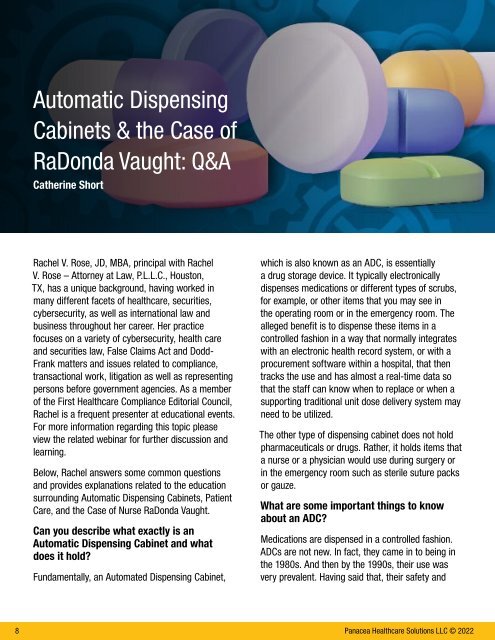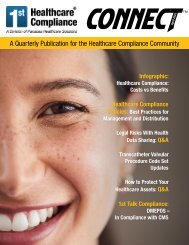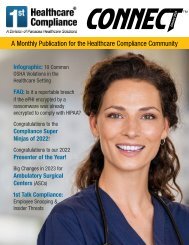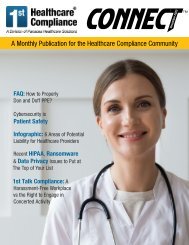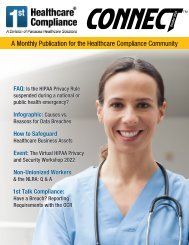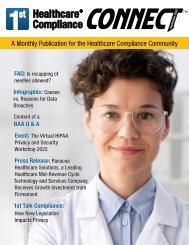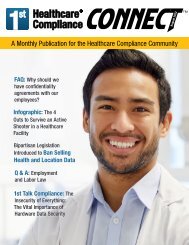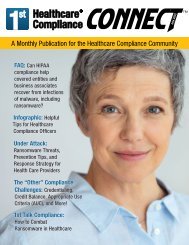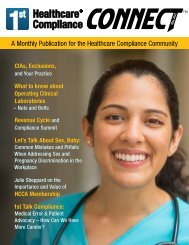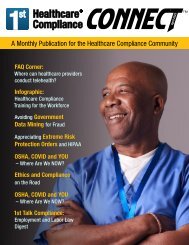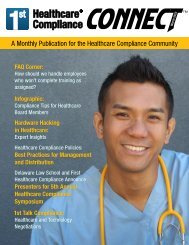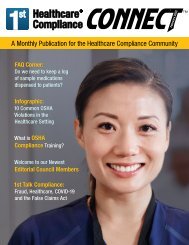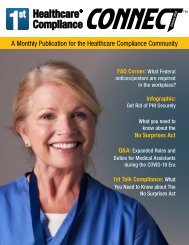First Healthcare Compliance CONNECT November 2022
Create successful ePaper yourself
Turn your PDF publications into a flip-book with our unique Google optimized e-Paper software.
Automatic Dispensing<br />
Cabinets & the Case of<br />
RaDonda Vaught: Q&A<br />
Catherine Short<br />
Rachel V. Rose, JD, MBA, principal with Rachel<br />
V. Rose – Attorney at Law, P.L.L.C., Houston,<br />
TX, has a unique background, having worked in<br />
many different facets of healthcare, securities,<br />
cybersecurity, as well as international law and<br />
business throughout her career. Her practice<br />
focuses on a variety of cybersecurity, health care<br />
and securities law, False Claims Act and Dodd-<br />
Frank matters and issues related to compliance,<br />
transactional work, litigation as well as representing<br />
persons before government agencies. As a member<br />
of the <strong>First</strong> <strong>Healthcare</strong> <strong>Compliance</strong> Editorial Council,<br />
Rachel is a frequent presenter at educational events.<br />
For more information regarding this topic please<br />
view the related webinar for further discussion and<br />
learning.<br />
Below, Rachel answers some common questions<br />
and provides explanations related to the education<br />
surrounding Automatic Dispensing Cabinets, Patient<br />
Care, and the Case of Nurse RaDonda Vaught.<br />
Can you describe what exactly is an<br />
Automatic Dispensing Cabinet and what<br />
does it hold?<br />
Fundamentally, an Automated Dispensing Cabinet,<br />
which is also known as an ADC, is essentially<br />
a drug storage device. It typically electronically<br />
dispenses medications or different types of scrubs,<br />
for example, or other items that you may see in<br />
the operating room or in the emergency room. The<br />
alleged benefit is to dispense these items in a<br />
controlled fashion in a way that normally integrates<br />
with an electronic health record system, or with a<br />
procurement software within a hospital, that then<br />
tracks the use and has almost a real-time data so<br />
that the staff can know when to replace or when a<br />
supporting traditional unit dose delivery system may<br />
need to be utilized.<br />
The other type of dispensing cabinet does not hold<br />
pharmaceuticals or drugs. Rather, it holds items that<br />
a nurse or a physician would use during surgery or<br />
in the emergency room such as sterile suture packs<br />
or gauze.<br />
What are some important things to know<br />
about an ADC?<br />
Medications are dispensed in a controlled fashion.<br />
ADCs are not new. In fact, they came in to being in<br />
the 1980s. And then by the 1990s, their use was<br />
very prevalent. Having said that, their safety and<br />
8<br />
Panacea <strong>Healthcare</strong> Solutions LLC © <strong>2022</strong>


